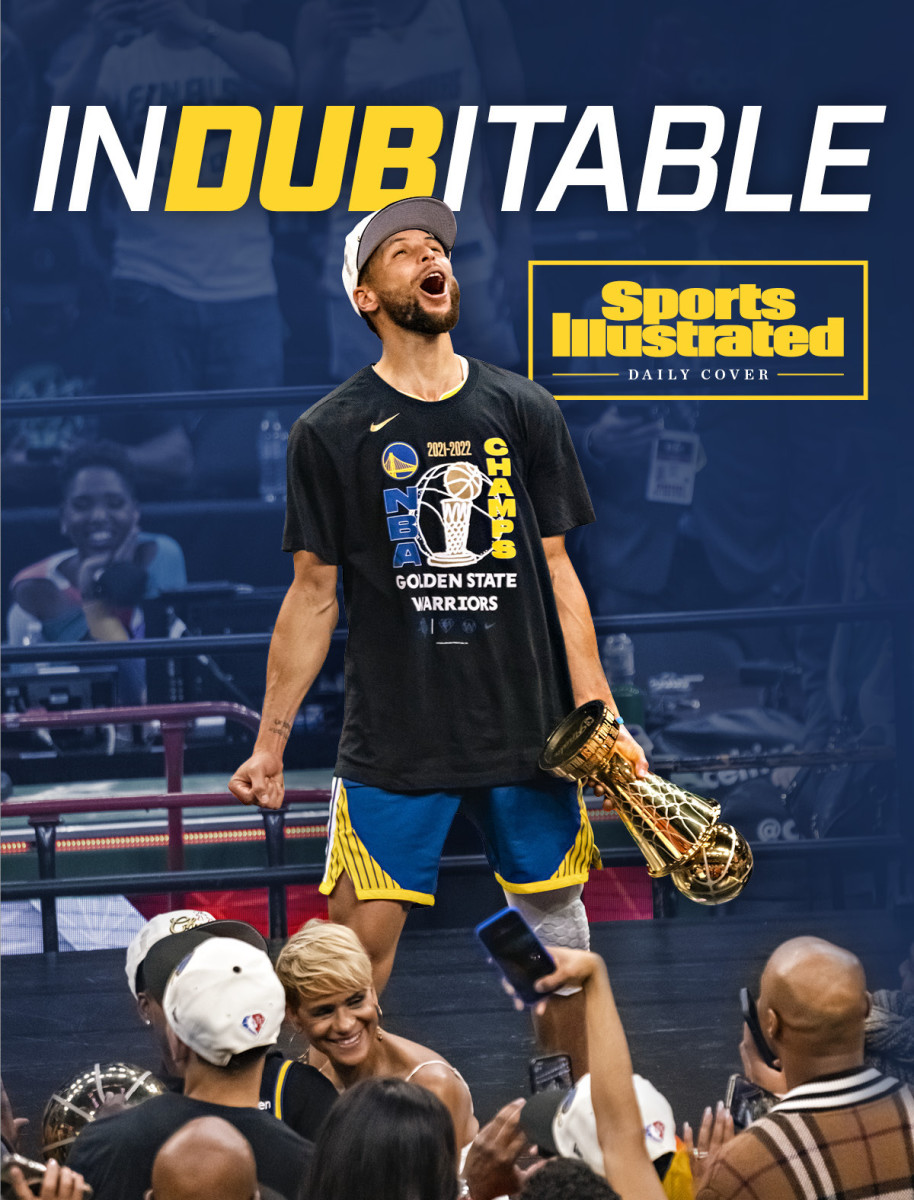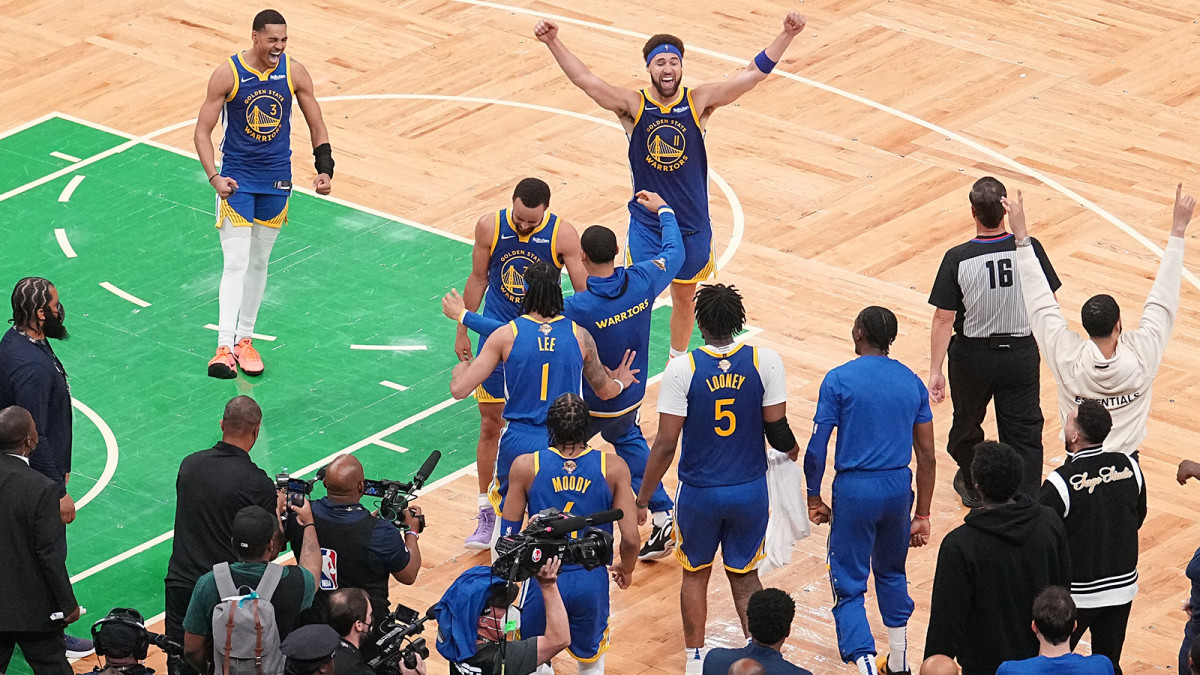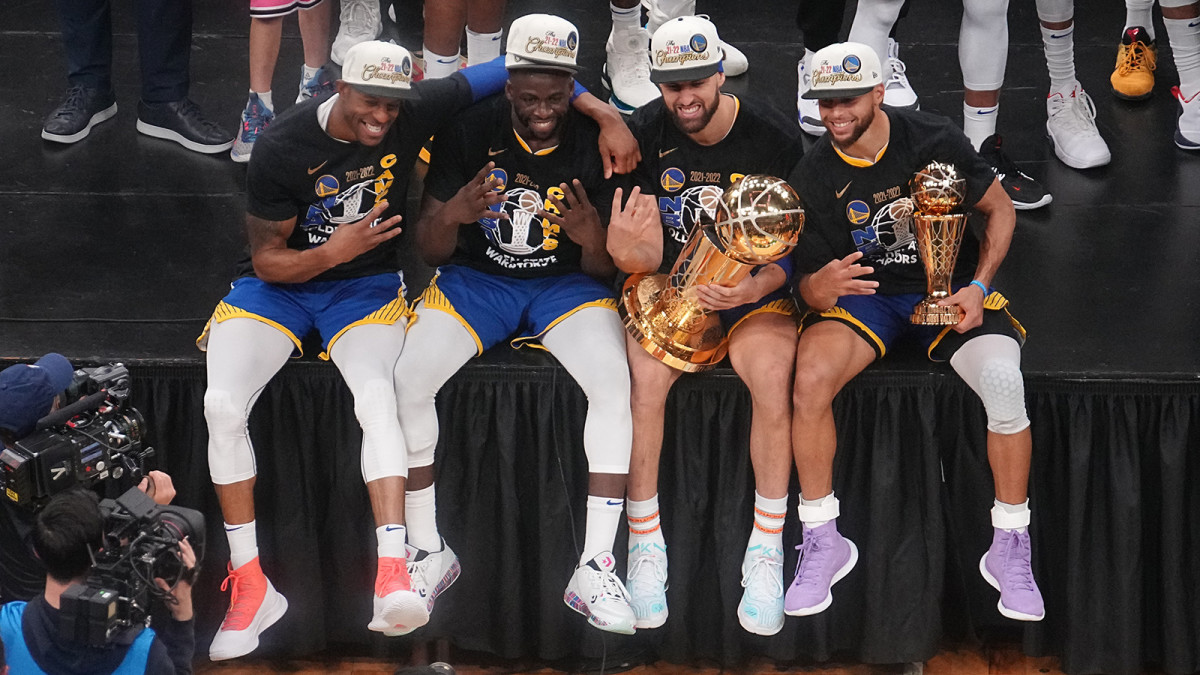Inside the Warriors’ Long-Awaited Return to Glory
They’d danced this celebratory dance before, the steps familiar, the rhythm ever-changing: first, with an innocent joyfulness, later with a chest-thumping exuberance. And this time, with tears and defiance and a renewed appreciation for the journey.
The Warriors of Golden State reclaimed their preeminence Thursday night, dispatching the Celtics in a six-game NBA Finals, earning their fourth championship in eight years and cementing them among the greatest dynasties of all time. It bore all the familiar features—all the Stephen Curry threes (and shimmies), all the Klay Thompson shooting flourishes, all the Draymond Green bravado and defensive brilliance that carried this team to glory in 2015 and ’17 and ’18.
And yet it was ultimately like none of them, and perhaps a little sweeter. Not more significant, but maybe more gratifying. Because the Warriors of 2022 don’t have the youthful legs they did in ’15, or the sheer, overwhelming firepower they did in ’17 and ’18. They’ve shed some high-powered talent along the way, said farewell to friends along the way, shredded ligaments and fractured bones along the way, and were forced to consider, more than once, whether they could ever do this again.
So when the final seconds were expiring Thursday on a 103–90 victory, Curry did not whoop or hop or pump his fists. He got misty-eyed. Put his hands on his head. Dropped to the floor. And he let the tears flow.
“These last two months of the playoffs, these last three years, this last 48 hours, every bit of it has been an emotional roller coaster, on and off the floor,” Curry said later. “And you’re carrying all of that on a daily basis to try to realize a dream and a goal like we did tonight. And you get goosebumps just thinking about all those snapshots and episodes that we went through to get back here, individually, collectively.”

And that, Curry said, is why “this championship hits different.” And why the emotions were so strong—“just because of what it took to get back here.”
It took Curry having the best June run of his career—with averages of 31.2 points, six rebounds and five assists, and a .437 success rate from the arc, all against the NBA’s top-rated defense—a performance that earned him his first Finals MVP.
It took steady contributions from old hands like Thompson and Green, and newcomers like Andrew Wiggins and Jordan Poole. It took Thompson returning from ACL and Achilles surgeries, and Andre Iguodala returning from a temporary exile. It took some of the best defense the Warriors have played, as they repeatedly flustered Celtics stars Jayson Tatum and Jaylen Brown, holding Boston under 100 points in each of their four wins.
“That’s always been a constant,” Green said. “You don’t win a championship without a great defense. We know that. We understand that.”
SI Presents: Golden State Warriors, 2022 NBA Champions
The first three titles certified the Curry-era Warriors as a dynasty. This one, the most unlikely of the bunch, puts them on another plane. They’re the first team since the 1990s Bulls to win at least four titles in an eight-year span, and the first since the Bulls to make six Finals over eight seasons. Only two franchises have won more titles than Golden State since the Bulls’ reign ended: the Lakers (with six), and the Spurs (with five).
Among the all-time greats, Curry now has as many rings as Shaquille O’Neal and LeBron James, and just one fewer than Kobe Bryant, Tim Duncan and Magic Johnson. Whatever skepticism might have lingered—about Curry’s greatness, his will, his worthiness of a top-15 all-time billing—should rightfully have been shattered over the last two weeks.
If the 2015 run was, as the Warriors framed it, a “Strength in Numbers” campaign, and the ’17 and ’18 titles were stamped by Kevin Durant, then this one was clearly, indisputably Curry’s.
“I think he solidified himself today—not even today, just his career—as the best point guard of all time,” Iguodala said.

In winning it all again, the Warriors defied everything about this dizzying NBA era, where superpowers rise and fall faster than the crypto market. Three years ago the Warriors appeared headed for a similar fate—with Thompson injured, Durant defecting, Iguodala traded and others moving on. This championship extended the dynasty by building on the ashes of the previous edition.
There was Wiggins—acquired by turning Durant into D’Angelo Russell and Russell into a key trade chip—averaging 18.3 points and throttling Tatum all series. There was Poole—taken with the 28th pick, seven days after the Warriors crashed in the 2019 Finals—hitting key threes and averaging 13.2 points.
There was Green—written off a dozen times in the three years since their last Finals (and maybe a couple of times this postseason)—threading perfect scoring passes and infusing the defense with his energy. There was Thompson, who just started playing basketball again in January, after a two-and-a-half-year absence, averaging 17 points.
“Strength in numbers,” Thompson said, “is alive and well.”
That they were back on this stage at all was remarkable, given all the Warriors have endured since losing to the Raptors in the 2019 Finals. That they won this title, convincingly—defeating a Celtics team that was younger, deeper, more athletic and by some assessments more talented—almost feels miraculous.
No one would have believed it until it happened. No one except the Warriors themselves. And, well, even they had their moments of doubt.
The low point? The emotional nadir? There were so many to choose from.
Durant’s blown Achilles in the 2019 Finals. Thompson’s blown ACL three days later. Durant’s defection to Brooklyn a few weeks later. The trade of Iguodala, a foundational figure and ’15 Finals MVP, for salary-cap purposes. And that was just one summer.
Then came Curry’s broken hand, in a freak accident that October, in the fourth game of the new season.
“That was probably the emotional low point,” Kerr told Sports Illustrated earlier in the series. “We could feel it’s gonna be a tough year already without Klay and with just losing so many guys. … And then when we lost Steph, it was like, you gotta be kidding me. Like, what is happening?’”
It quickly got worse. By late December, the Warriors were 5–24, already out of the playoff race. Green was their sole remaining All-Star. And he was miserable, later admitting he briefly lost his love for the game.
“You play basketball at the highest level, and then to go play at the absolute lowest level,” Green, reflecting back, says. “That's no fun. Not having a chance at winning is never something that’s sat well with me.”
Three hundred ninety-two miles to the south, Curry was having his own existential crisis. He spent two months in Hermosa Beach, working daily with a hand therapist after surgery and watching his team lose game after game after game in his absence.
“You talk about low point,” Curry says, “but that was where it seemed like there was the most amount of work to do to get back to this stage. Especially because you’re not even in the building, you're not even around the team. It almost feels like an out-of-body experience watching the guys struggle, knowing that I got a long road ahead just to even be healthy to play. And then the pandemic happens, and you're on pause again. So that was emotionally very difficult for a lot of reasons.”

It ended with another low: a 15–50 record, the Warriors’ worst winning percentage in nearly two decades. And by some accounts, they still hadn’t bottomed out. That moment came on Nov. 19, 2020, when Thompson—having fully recovered from his ACL tear—ruptured his right Achilles, putting him back on the shelf for another 14 months.
“Because it freakin’ hurt,” Thompson says, “and then on top of that it was a long road back. I was just getting back in game shape and feeling great.”
The entire franchise winced with him. Thompson is not just respected and valued, but universally beloved. This wasn’t just a blow to the Warriors’ lineup, but their collective psyche. And a second straight season without him would be a struggle. Which brings us to one last low and the moment when even some team officials felt their faith wane.
It was December 2020, and the Warriors opened their COVID-19-delayed season by getting routed, in succession, in Brooklyn (125–99) and Milwaukee (138–99).
“We got crushed,” Warriors GM Bob Myers says. “I thought, This is pretty bad. This is bad. This isn't going to work. And the problem is as an executive, when you step into a season and learn after two games, you’re getting blown out twice? There’s not a lot of recourse, because you’ve made your decisions. … So I was sitting there thinking, I don't know what we’re gonna do. And that was probably the low point.”
“In this job, you know you’re gonna lose,” Myers said. “But when you’re getting destroyed, it's almost like there was a futility at the outset of that as an executive, thinking, I may have really screwed this up.”
But the Warriors weren’t over, just momentarily stalled out. Myers hadn’t screwed up; he just hadn’t yet figured out the way forward. Belief and ambition brought the Warriors back.
There’s one transaction that still haunts Myers to this day, but it’s the one that made this entire revival possible: the trade that sent Iguodala (and his contract) to Memphis in July 2019.
That deal allowed the Warriors to execute the complicated sign-and-trade transactions that sent Durant to Brooklyn in exchange for Russell. And they eventually parlayed Russell into Wiggins, who simply became the Warriors’ best wing defender and an All-Star and an absolutely essential piece.
“It's the worst thing,” Myers says of the Iguodala deal. “The worst thing. It felt immoral. It felt like, this isn't how you treat somebody that's done what he's done for us. … That was the one where I was like, I don't know if I can be in a business where I’ve got to do stuff like this to people like him. This isn't how it should be.”
And yet those maneuvers were critical for the Warriors to infuse the roster with new talent.
“We immediately had a strategy to deal with all this,” Warriors owner Joe Lacob says. “We didn't just sit around and sulk.”
Myers and Kerr knew this much, too: Change was essential, unavoidable. Dynasties grow weary and stale. They need fresh energy. Kerr had lived it, as a member of the Bulls’ second three-peat in the 1990s. The Warriors were the first team in the modern era to make five straight Finals, and the toll was evident—even without the injuries.
“The hard part was just how physically and emotionally spent we were after five years,” Kerr said. “The absolute and utter exhaustion is something that nobody can really understand unless they were part of the run.”
And so Myers started shuffling the deck, making calculated bets and methodically replenishing the rotation. There were misfires (Kelly Oubre Jr., Kent Bazemore), but many more hits: Wiggins, Poole, Gary Payton II, Otto Porter Jr., all key rotation members this season.
“There was never a moment where we felt it was over,” Kerr said. “There was always the thought in the back of our minds, or even in the front, that when we get everybody back, we can make another push.”

The stars would eventually get healthy again. But they wouldn’t get anywhere without the kind of support they had when this all began. Along the way, the Warriors made the bold (and among some fans, controversial) decision not to trade their high draft picks for veterans. They would instead pursue a dual path: title contention now, player development to ensure their future.
Those prospects—James Wiseman, Jonathan Kuminga and Moses Moody—had a negligible impact on this run. Had the Warriors lost, Myers and Lacob would have been lit up by Warriors fans. But the gambit worked.
“No one's done it, I know. And we got criticized,” Lacob said. “But this is what we're doing. We believe in this plan. That's our plan. And look, I hate to say I told you so …”
They can say it now, with confidence and perhaps an earned bit of smugness. They pulled it off. The Warriors are champions again. Their present is assured, and their future is bright. As Lacob sees it, with the benefits of modern sports science, Curry, Thompson and Green can play into their late 30s. The prospects will grow into greater roles and help ease their burden as the years advance.
“I never thought we were done,” Lacob said. “Personally, I think we're set up for the rest of the decade.”
From the owner’s suite to the locker room, the belief endures. The swagger endures. It carried them through the crash-and-burn of the 2019 Finals, through all the physical and emotional trauma, through all the difficult goodbyes and calculated gambles, through all the tears of anguish until finally, standing on the historic parquet in Boston, they could shed tears of joy.
No one could have predicted, with any certainty, that they’d be here. But, the Warriors will tell you, they never stopped believing.
“I was thinking about Draymond and Klay and myself,” Curry says. “When we're healthy, we’re good. And there’s a lot of confidence in the fact that if we can just get back to being healthy and having a chance to play that we can figure it out again, and create this vibe again.
“So I wouldn’t say ‘doubt.’ Just patience.”
More SI Daily Cover Stories:
• Steph Curry Is Dominating the NBA Like Never Before
• Inside the Celtics' Dramatic Turnaround
• The Warriors’ Daring Quest to Extend Dynasty Run
